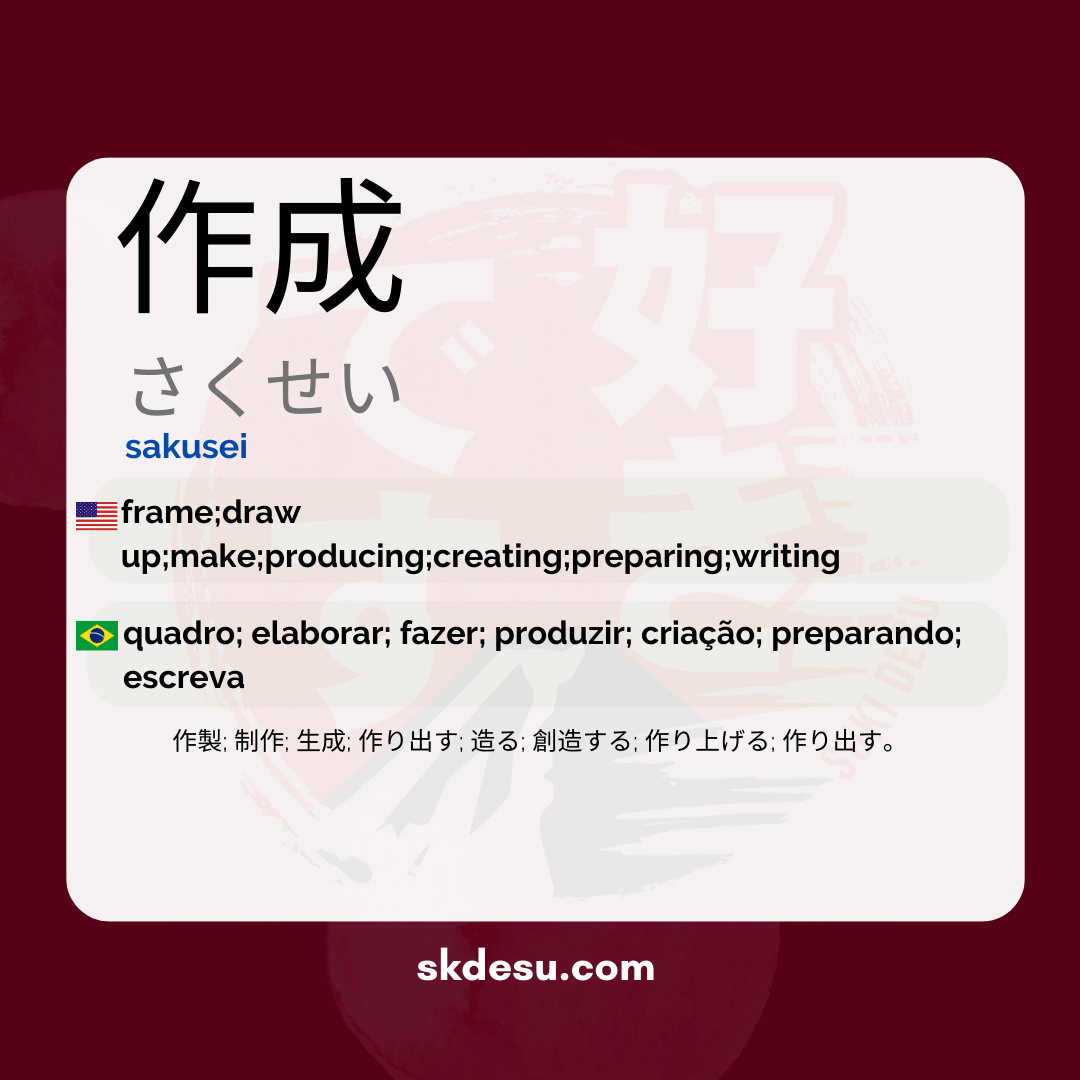Translation and Meaning of: 作成 - sakusei
The Japanese word 作成 [さくせい] is a term that frequently appears in formal and bureaucratic contexts, but also in the daily life of those who study or work with documents and projects. In this article, we will explore its meaning, origin, and practical use, as well as understand how it fits into the Japanese language. If you have ever wondered how to memorize this vocabulary or in what situations it is most commonly used, keep reading to find out.
In the Suki Nihongo dictionary, 作成 is defined as "creation" or "elaboration," especially related to documents, plans, or written materials. However, there are interesting nuances in its use that are worth knowing. Let's dive into the details of this word and uncover its particularities.
Meaning and use of 作成
The term 作成 is composed of the kanjis 作 (to create, to make) and 成 (to complete, to accomplish), forming the idea of "completed elaboration." Unlike words like 作る (tsukuru), which has a more general meaning of "to do," 作成 carries a more formal and specific connotation. It is often used in professional contexts, such as in the preparation of reports, contracts, or presentations.
A common example is the expression 書類を作成する (shorui o sakusei suru), which means "to create documents." Companies and government agencies often use this term to refer to the production of official materials. It's worth noting that, although it can be used in everyday conversations, 作成 sounds more technical than other alternatives.
Origin and structure of kanjis
The etymology of 作成 traces back to classical Chinese, where the characters 作 and 成 were already combined with a similar meaning. The kanji 作 appears in words such as 作品 (sakuhin, "work of art") and 作業 (sagyou, "work"), while 成 is present in terms like 成功 (seikou, "success") and 成長 (seichou, "growth"). Together, they reinforce the idea of something that has been created and completed.
One tip to memorize this word is to associate the radical 亻(person) in 作 with the human action of creating, while 成 brings the radical 戈 (spear), which historically represented completion or accomplishment in military contexts. This visual combination helps to reinforce the meaning of "something made by someone and completed."
Cultural contexts and frequency of use
In Japan, 作成 is a word quite present in corporate and academic environments. Its use reflects the appreciation for precision and documentation in Japanese culture, where bureaucratic processes are often detailed. In contrast, in informal situations, the Japanese tend to choose simpler verbs, such as 作る or 書く (kaku, "to write").
Interestingly, 作成 also appears in Japanese software and applications, typically in buttons like "新規作成" (shinki sakusei, "create new file"). This presence in technology shows how the term is embedded in practical contexts. For Japanese learners, recognizing this word in interfaces can be a natural way to absorb it.
Vocabulary
Expand your vocabulary with related words:
Synonyms and similar words
- 作製 (sakusei) - Production or manufacturing of a specific object.
- 制作 (seisaku) - Creation or production, especially in arts and media.
- 生成 (seisei) - Generation or creation, often used in contexts of natural or digital production.
- 作り出す (tsukuridasu) - Start producing; create something new.
- 造る (tsukuru) - Build or make; it generally refers to more physical works.
- 創造する (souzou suru) - Act in a creative way; creation in the artistic or conceptual sense.
- 作り上げる (tsukuriageru) - Complete the construction of something; finish a work.
Related words
Romaji: sakusei
Kana: さくせい
Type: noun
L: jlpt-n2
Translation / Meaning: frame; elaborate; to do; to produce; creation; preparing; Write
Meaning in English: frame;draw up;make;producing;creating;preparing;writing
Definition: Create something new using the knowledge of a language.
Quick Access
- Vocabulary
- Writing
- Sentences
How to Write in Japanese - (作成) sakusei
See below a step-by-step guide on how to write the word by hand in Japanese. (作成) sakusei:
Example Sentences - (作成) sakusei
See below some example sentences:
Puroguramu wo sakusei suru no wa tanoshii desu
Creating a program is fun.
Creating a program is fun.
- プログラム (puroguramu) - Program
- を (wo) - Particle that marks the direct object of the sentence
- 作成する (sakusei suru) - Create, produce
- のは (no wa) - Particle that marks the subject of the sentence
- 楽しい (tanoshii) - Fun, pleasant
- です (desu) - Particle that indicates the polite or polite form of the sentence
Sakusei suru koto wa juuyou desu
Creating is important.
Creating is important.
- 作成する - It means "to create" or "to produce".
- こと - It is an abstract noun that means "thing" or "fact".
- は - It is a particle that indicates the topic of the sentence, in this case "create" or "produce".
- 重要 - It means "important" or "crucial."
- です - is a polite way of saying "ser" or "estar".
Other Words of this Type: noun
See other words from our dictionary that are also: noun

